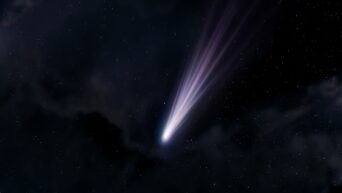On today’s episode of “completely impractical but still kind of neat science,” we posit the following question: if there is intelligent life somewhere else in the universe, how can we let them know that, out of every other lifeless planet, ours happens to have living beings on it? Apparently, according to MIT researcher James Clark, the answer is a porch light. Specifically, a gigantic radioactive laser porch light. Of course, it’s so obvious.
Clark believes that if we were to focus a 1-2 megawatt laser through a 30-45 meter telescope and fire it into space, the resulting radioactive beacon would be distinct enough from the sun in terms of light and energy composition to be spotted by an alien astronomer. If the signal were to be received and another fired off in return, the beacon could also be used to send coded messages via Morse code. Creating the beacon is more than possible right now; a 39-meter telescope is under construction in Chile, and the US Air Force has laser prototypes with the right wattage.
Firing off the beacon, however, could have detrimental effects on satellite imaging systems, as well as the eyes of anyone unfortunate enough to be looking up at the time. Clark believes this could be remedied by building the beacon on the dark side of the moon. Because I guess that was on the table.
































